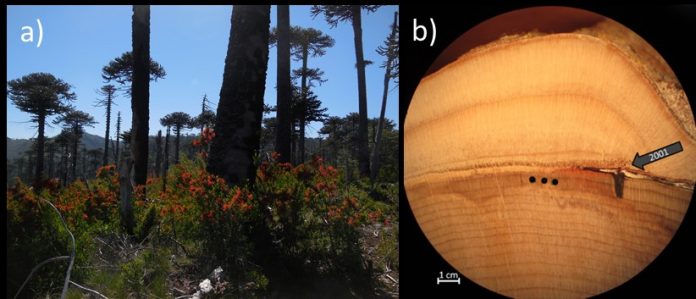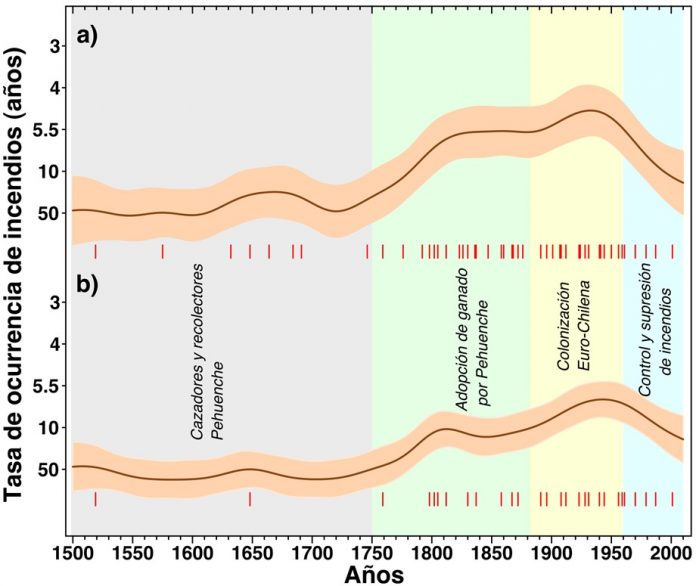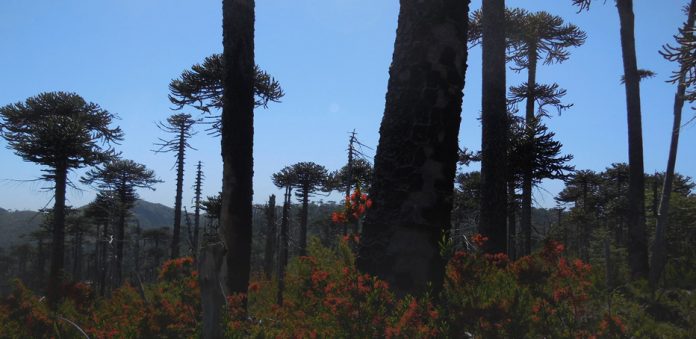Mauro E. González, associate investigator, Center for Climate and Resilience Research (CR)2; Ariel Muñoz, adjunct investigator, Center for Climate and Resilience Research (CR)2; Álvaro González-Reyes, Hémera Earth Observation Center, Universidad Mayor; Duncan Christie, associate investigator, Center for Climate and Resilience Research (CR)2; and Jason Sibold, Department of Anthropology and Geography, Colorado State University
- A study that reconstructed the history of fires in the Andean Araucaria forests of north-western Patagonia brought to light that these fires were influenced by the land use practices of the Pehuenche people and especially by Euro-Chilean colonization. It also determined that major fires are aided by climatic variables such as the El Niño Southern Oscillation (ENSO) and the Southern Annular Mode (SAM).
Fire has been one of the main ecological processes that has shaped the (Araucaria araucana) forests in Chile and Argentina over the past few millennia. Studies seeking to reconstruct the history of fires in those forests have documented the significant influence that both the climate and humans have had on the frequency, severity, and extension of those fires.
A recent investigation [1] published in the International Journal of Wildland Fire was aimed at using dendrochronological methods (the study of tree rings, Figure 1) to reconstruct the history of fire in the Andean Araucaria forests located in north-western Patagonia over the past 500 years, and to determine how humans and the climate had influenced the occurrence of those fires.
 Figure 1. a) Araucaria forest recovering after the major fire that occurred in February 2002 (dendrochronological year 2001), and b) Araucaria growth rings showing fire scars from the fire that occurred at the end of summer.
Figure 1. a) Araucaria forest recovering after the major fire that occurred in February 2002 (dendrochronological year 2001), and b) Araucaria growth rings showing fire scars from the fire that occurred at the end of summer.
This reconstruction shows that the Araucaria forests have been shaped by major fires, in combination with other less extensive and less severe events, with humans being an important factor in modifying the natural fire regime of these forests. Beginning in 1750, mountain-dwelling Pehuenche groups had a moderate influence on increasing the frequency of forest fires with their adoption of livestock raising, including the use of controlled burns during summer pasturing periods (veranada) in the high Andes. These burns were carried out to improve the natural grasslands and open mountain passes to drive their herds from the pampas of Argentina to the Chilean side of the mountains. However, the greatest change in the fire regime occurred with Euro-Chilean colonization from 1883 to the 1950s. In that period, the intense removal of forests to open land for agriculture and ranching and the logging of the Araucaria forests for timber caused a tenfold increase in the frequency of fires compared to the natural historic regime before 1700 (Figure 2).
In another key finding, this investigation confirmed that severe, extensive fires are closely linked to climate events associated with large-scale phenomena such as the El Niño Southern Oscillation (ENSO) and the Antarctic or Southern Annular Oscillation (SAM). In the past few centuries, the occurrence of El Niño and positive SAM phases triggered warm dry summers, which in turn facilitated major fires. Furthermore, the coincidentally low flow regime of the River Imperial – the largest waterway in the area of study – confirm the hydric stress that was conducive to fires in these forests.
 Figure 2. Fire occurrence rate (years) for historic periods after 1500, considering: a) all fires recorded and b) fires occurring in two or more sites of Parque Nacional Tolhuaca (95% confidence interval with 1,000 simulations). The red vertical lines represent fire events.
Figure 2. Fire occurrence rate (years) for historic periods after 1500, considering: a) all fires recorded and b) fires occurring in two or more sites of Parque Nacional Tolhuaca (95% confidence interval with 1,000 simulations). The red vertical lines represent fire events.
Even though the frequency of fires has diminished since 1950, in recent decades (2000-2020) the Andean Araucaria forests have been affected by a series of major fires, both anthropogenic and naturally occurring, that were very severe and extensive. In the summer of 2002, for example, simultaneous fires caused by lightning strikes affected large tracts of Araucaria forest, including some in officially protected parks and reserves. In 2015, once again, naturally occurring and anthropogenic factors caused major fires in the Andes Mountains that in some places, including the Tolhuaca National Park and the Malleco National Reserve, affected areas previously burned in 2002.
Lastly, future projections indicate that drought and higher temperatures in the Andes could produce a change in the fire regime of the Araucaria forests. Owing to this, understanding how climate affects the occurrence of fires in these Andean environments, as well as the ways in which the forests themselves respond to these changes, are key pieces of the puzzle in the conservation of these ecosystems.
Notes
[1] González Mauro E., Muñoz Ariel A., González-Reyes Álvaro, Christie Duncan A., Sibold Jason (2020) Fire history in Andean Araucaria–Nothofagus forests: coupled influences of past human land-use and climate on fire regimes in north-west Patagonia. International Journal of Wildland Fire 29, 649-660.




